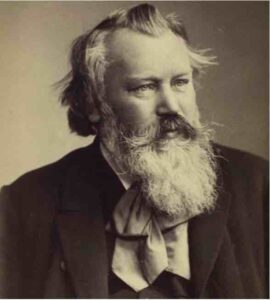Brahms Johannes (1833-1897) Ungarischer Tanz No.6

Johannes Brahms, geboren in Hamburg, gestorben in Wien war Komponist, Pianist und Dirigent. Seine Kompositionen werden vorwiegend der Hochromantik zugeordnet; durch die Einbeziehung klassischer Formen gehen sie aber über diese hinaus. Brahms zählt zu den bedeutendsten Komponisten des 19. Jahrhunderts.
Die Ungarischen Tänze Nr. 1–21 (WoO 1) von Johannes Brahms sind ursprünglich Werke für Klavier zu vier Händen. Sie entstanden in den Jahren 1858–69
Beim Ungarischen Tanz No. 6 handelt es sich nicht um originale Gedanken Brahms’, sondern um Bearbeitungen vorgefundener Melodien. Allerdings sind die Vorlagen auch keine originalen Volkslieder ungarischer Roma, vielmehr hatte Brahms die Themen von einem Geiger kennengelernt. Beim Tanz No. 6 wurde dabei die Tonart von Des auf D geändert. Die Ungarischen Tänze No. 5 und No. 6 und gehören zu seinen populärsten Werken von Johannes Brahms. Prof. Hackl bearbeitete beide Tänze sowohl für Bläser-Orchester als auch für Bläserquintett.

Johannes Brahms, born in Hamburg, died in Vienna, was a composer, pianist and conductor. His compositions are primarily assigned to the High Romantic period; But by incorporating classical forms, they go beyond them. Brahms is one of the most important composers of the 19th century.
The Hungarian Dances No. 1–21 (WoO 1) by Johannes Brahms are originally works for piano fourhands. They were created in the years 1858–69
At the Hungarian Dance No. 6 is not about Brahms’ original thoughts, but about adaptations of found melodies. However, the originals are not original folk songs from Hungarian Roma; rather, Brahms learned about the themes from a violinist At dance no. 6 the key was changed from D flat to D. The Hungarian Dances No. 5 and No. 6 and are among his most popular works by Johannes Brahms. Prof. Hackl arranged both dances for both a wind orchestra and a wind quintet.
| sound sample / Tonbeispiel | score/parts PDF download: € 38,- | add to cart / in den Warenkorb |
